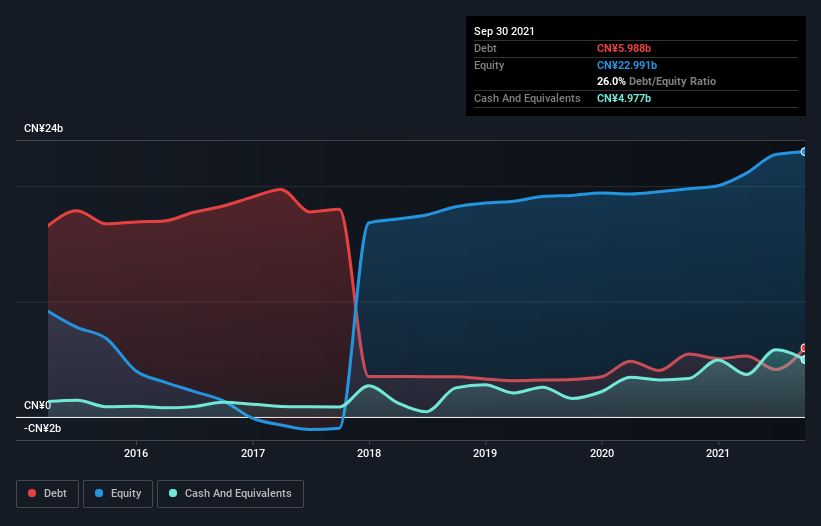
Some say volatility, rather than debt, is the best way to think about risk as an investor, but Warren Buffett famously said that 'Volatility is far from synonymous with risk.' So it might be obvious that you need to consider debt, when you think about how risky any given stock is, because too much debt can sink a company. As with many other companies Chongqing Iron & Steel Company Limited (HKG:1053) makes use of debt. But the real question is whether this debt is making the company risky.
When Is Debt Dangerous?
Debt assists a business until the business has trouble paying it off, either with new capital or with free cash flow. If things get really bad, the lenders can take control of the business. However, a more frequent (but still costly) occurrence is where a company must issue shares at bargain-basement prices, permanently diluting shareholders, just to shore up its balance sheet. Of course, the upside of debt is that it often represents cheap capital, especially when it replaces dilution in a company with the ability to reinvest at high rates of return. When we think about a company's use of debt, we first look at cash and debt together.
Check out our latest analysis for Chongqing Iron & Steel
What Is Chongqing Iron & Steel's Net Debt?
The image below, which you can click on for greater detail, shows that at September 2021 Chongqing Iron & Steel had debt of CN¥5.99b, up from CN¥5.45b in one year. However, it does have CN¥4.98b in cash offsetting this, leading to net debt of about CN¥1.01b.

How Strong Is Chongqing Iron & Steel's Balance Sheet?
We can see from the most recent balance sheet that Chongqing Iron & Steel had liabilities of CN¥13.5b falling due within a year, and liabilities of CN¥5.14b due beyond that. Offsetting these obligations, it had cash of CN¥4.98b as well as receivables valued at CN¥1.85b due within 12 months. So its liabilities total CN¥11.8b more than the combination of its cash and short-term receivables.
This is a mountain of leverage relative to its market capitalization of CN¥16.3b. This suggests shareholders would be heavily diluted if the company needed to shore up its balance sheet in a hurry.
We use two main ratios to inform us about debt levels relative to earnings. The first is net debt divided by earnings before interest, tax, depreciation, and amortization (EBITDA), while the second is how many times its earnings before interest and tax (EBIT) covers its interest expense (or its interest cover, for short). This way, we consider both the absolute quantum of the debt, as well as the interest rates paid on it.
Chongqing Iron & Steel's net debt is only 0.22 times its EBITDA. And its EBIT covers its interest expense a whopping 10.4 times over. So you could argue it is no more threatened by its debt than an elephant is by a mouse. Better yet, Chongqing Iron & Steel grew its EBIT by 573% last year, which is an impressive improvement. If maintained that growth will make the debt even more manageable in the years ahead. There's no doubt that we learn most about debt from the balance sheet. But it is Chongqing Iron & Steel's earnings that will influence how the balance sheet holds up in the future. So if you're keen to discover more about its earnings, it might be worth checking out this graph of its long term earnings trend.
Finally, a business needs free cash flow to pay off debt; accounting profits just don't cut it. So we clearly need to look at whether that EBIT is leading to corresponding free cash flow. In the last three years, Chongqing Iron & Steel created free cash flow amounting to 2.9% of its EBIT, an uninspiring performance. For us, cash conversion that low sparks a little paranoia about is ability to extinguish debt.
Our View
Both Chongqing Iron & Steel's ability to to grow its EBIT and its net debt to EBITDA gave us comfort that it can handle its debt. In contrast, our confidence was undermined by its apparent struggle to convert EBIT to free cash flow. Considering this range of data points, we think Chongqing Iron & Steel is in a good position to manage its debt levels. Having said that, the load is sufficiently heavy that we would recommend any shareholders keep a close eye on it. Over time, share prices tend to follow earnings per share, so if you're interested in Chongqing Iron & Steel, you may well want to click here to check an interactive graph of its earnings per share history.
If, after all that, you're more interested in a fast growing company with a rock-solid balance sheet, then check out our list of net cash growth stocks without delay.
New: AI Stock Screener & Alerts
Our new AI Stock Screener scans the market every day to uncover opportunities.
• Dividend Powerhouses (3%+ Yield)
• Undervalued Small Caps with Insider Buying
• High growth Tech and AI Companies
Or build your own from over 50 metrics.
Have feedback on this article? Concerned about the content? Get in touch with us directly. Alternatively, email editorial-team (at) simplywallst.com.
This article by Simply Wall St is general in nature. We provide commentary based on historical data and analyst forecasts only using an unbiased methodology and our articles are not intended to be financial advice. It does not constitute a recommendation to buy or sell any stock, and does not take account of your objectives, or your financial situation. We aim to bring you long-term focused analysis driven by fundamental data. Note that our analysis may not factor in the latest price-sensitive company announcements or qualitative material. Simply Wall St has no position in any stocks mentioned.
About SEHK:1053
Chongqing Iron & Steel
Engages in the production and sale of steel plates in the People’s Republic of China.
Good value with adequate balance sheet.
Market Insights
Community Narratives




